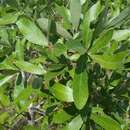More info for the terms:
avoidance,
climax,
codominant,
fire frequency,
fire intensity,
fire regime,
fire suppression,
frequency,
fuel,
hardwood,
litter,
mesic,
natural,
presence,
root crown,
surface fire,
xericBluejack oak is well adapted to survive fire and may be dependent on
fire to maintain the open conditions that it requires to be competitive.
It occurs in longleaf pine communities which are described as a fire
climax. The natural fire regime of longleaf pine communities is
characterized by frequent low-intensity surface fires [
6,
27,
36]. A
decrease in fire frequency favors scrub oaks over longleaf pine, but
very long fire-free periods are unfavorable to bluejack oak. In the
absence of fire, bluejack oak is outcompeted by taller and more shade
tolerant species such as laurel oak (Quercus laurifolia) and sand live
oak [
28,
47]. Top-killed or top-damaged bluejack oak sprout from the
root crown following fire [
13,
27,
28,
33].
Bluejack oak occurs in highly fire-adapted and fire-dependent
communities on dry sandhills. Where longleaf pine and wiregrass are
dominant, sufficient litter builds up and fires occur frequently,
sometimes annually. The natural interval is thought to be 3 to 10
years. Sufficient fuel to carry surface fire accumulates in about 3 to
4 years [
6]. The natural fire regime was maintained or expanded for
thousands of years by human-set fires. In presettlement times Native
Americans burned these communities for a number of purposes, usually at
short intervals. European settlers continued the practice to improve
grazing, remove "rough", and reduce plant diseases and insects. Fire
suppression and fire avoidance (meaning no fires were set) were
practiced in the early parts of this century until the beneficial
effects of fire were recognized and began to be incorporated into
management plans [
6,
18].
There are a number of hypotheses to explain the presence of bluejack oak
in longleaf pine communities. Garren [
13] differentiated between the
typical longleaf pine community, which has no hardwood midstory, and
longleaf pine-scrub oak types. These oaks include turkey oak, blackjack
oak, sand post oak, and bluejack oak. He proposed that scrub oak
reproduction appears in small openings in typical longleaf pine forests,
establishing on soils which are so dry and sandy that other plants grow
poorly and are unable to compete. Annual or frequent fires thin
longleaf pine reproduction and allow an increase in the number of scrub
oak stems through sprouting; continued frequent fire maintains the
presence of these fire-tolerant scrub oaks in the community [
13].
Longleaf pine has been slow to reinvade areas from which it was removed;
the fire regime has been altered both by its absence and by fire
suppression [
6]. Bluejack oak is codominant with turkey oak or may be
the sole dominant on some former longleaf pine sandhills; it has been
suggested that bluejack oak is less tolerant of extremely xeric
conditions or prefers more fertile soils than does turkey oak [
28]. All
three phases of the longleaf pine-scrub oak type are fire maintained
[
6,
25]. The role of bluejack oak in these communities is determined by
fire and soil moisture regime; where turkey oak and bluejack oak
cooccur and where fire has been excluded for several decades, bluejack
oak abundance declines more rapidly than that of turkey oak [
28]. In
Florida, bluejack oak decreased dramatically in importance value between
1951 and 1972 in a longleaf pine-turkey oak stand that had not
experienced fire since 1931. However, on a longleaf pine-bluejack oak
site with a similar fire-free period, bluejack oak importance value
decreased only slightly between 1951 and 1972. The author hypothesized
that bluejack oak will probably continue to decline in the absence of
fire, and mesic hammock species will increase in importance [
39].
Bluejack oak is not a typical member of sand pine (Pinus clausa) scrub
communities, which occur on many of the same types of sandhills as
longleaf pine communities. Distribution and composition of sand pine
scrub appears to be related to edaphic conditions [
6]. These
communities are also fire maintained and fire-dependent; however, their
fire regime is quite different from that of the longleaf pine
communities. Sand pine scrub communities historically experienced
intense crown fires at intervals of 30 to 60 years [
6,
27]. The absence
of bluejack oak from these communities may have more to do with the
thick understory of evergreen oaks and/or edaphic conditions than with
fire intensity, but this relationship remains unexplored in the
literature.
FIRE REGIMES : Find fire regime information for the plant communities in which this
species may occur by entering the species name in the
FEIS home page under
"Find FIRE REGIMES".

